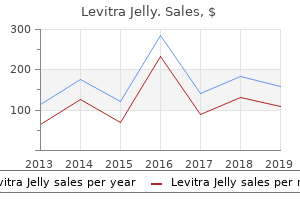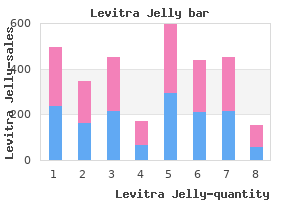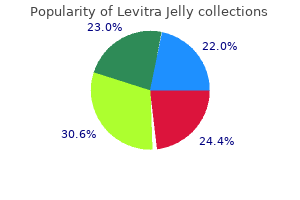Levitra Jelly
"Cheap levitra_jelly 20mg without prescription, erectile dysfunction treatment new orleans".
By: F. Konrad, M.A., Ph.D.
Program Director, Creighton University School of Medicine
Alteration of plasma phospholipid fatty acid profile in patients with septic shock erectile dysfunction 17 purchase levitra_jelly online. The Mediterranean diet improves hepatic steatosis and insulin sensitivity in people with non-alcoholic fatty liver illness what causes erectile dysfunction in males discount levitra_jelly online master card. Nutrition and healthy ageing: calorie restriction or polyphenol-rich "MediterrAsian" diet? Associations between dietary patterns and kidney operate indicators in kind 2 diabetes erectile dysfunction epilepsy medication discount generic levitra_jelly canada. Polyunsaturated fatty acid sample in liver and erythrocyte phospholipids from overweight patients. Hepatic n-3 polyunsaturated fatty acid depletion promotes steatosis and insulin resistance in mice: genomic analysis of mobile targets. Involvement of intestine microbiota within the growth of low-grade inflammation and type 2 diabetes associated with weight problems. Dietary fiber dietary supplements: effects in weight problems and metabolic syndrome and relationship to gastrointestinal functions. Postoperative modifications in fecal bacterial communities and fermentation products in overweight patients present process bilio-intestinal bypass. Duodenojejunal bypass results in altered intestine microbiota and Strengthened Epithelial limitations in rats. Clinical utility of probiotics in kind 2 diabetes mellitus: a randomized, double-blind, placebo-managed research. Effects of synbiotic meals consumption on metabolic status of diabetic patients: a [68] [69] [70] [71] [72] [seventy three] [74] [75] [seventy six] [77] [78] [79] [eighty] [eighty one] [eighty two] [eighty three] [84] [85] [86] [87] [88] [89] [90] [ninety one] R. Novel findings on the metabolic effects of the low glycaemic carbohydrate isomaltulose (Palatinose). A diabetes-specific enteral formulation improves glycemic variability in patients with kind 2 diabetes. Administration of a brand new diabetes-specific enteral formulation results in an improved 24h glucose profile in kind 2 diabetic patients. Diabetes-specific enteral diet formulation in hyperglycemic, mechanically ventilated, critically sick patients: a prospective, open-label, blind-randomized, multicenter research. Tube feeding with a diabetes-specific feed for 12 weeks improves glycaemic management in kind 2 diabetes patients. Slowly digestible carbohydrate sources can be utilized to attenuate the postprandial glycemic response to the ingestion of diabetes-specific enteral formulas. The association of preoperative glycemic management, intraoperative insulin sensitivity, and outcomes after cardiac surgery. Impact of a trimodal prehabilitation program on useful recovery after colorectal most cancers surgery: a pilot research. Glucose variability is an unbiased predictor of mortality in hospitalized patients treated with whole parenteral diet. Glycemic variability and mortality in critically sick patients: the influence of diabetes. A minimal blood glucose worth lower than or equal to 120 mg/dL underneath glycemic management is associated with increased 14-day mortality in nondiabetic intensive care unit patients with sepsis and stress hyperglycemia. Observation of incretin effects during enteral feed transitions of critically sick patients. Influence of enteral versus parenteral diet on blood glucose management in acute pancreatitis: a systematic evaluate. Effects of isoenergetic glucose-primarily based or lipid-primarily based parenteral diet on glucose metabolism, de novo lipogenesis, and respiratory gasoline exchanges in critically sick patients. Intensive insulin therapy in critically sick trauma patients normalizes glucose by decreasing endogenous glucose production. A prospective randomised multi-centre managed trial on tight glucose management by intensive insulin therapy in adult intensive care units: the Glucontrol research. It is the primary explanation for blindness in individuals between the ages of 20-64 within the United States.

During the past several years erectile dysfunction treatment prostate cancer cheap levitra_jelly 20 mg overnight delivery, nevertheless erectile dysfunction san francisco discount levitra_jelly 20mg free shipping, the accumulation of evidence from sophisticated studies inspecting -cell function and tissue insulin sensitivity erectile dysfunction ayurvedic drugs levitra_jelly 20mg overnight delivery, both cross-sectionally and longitudinally, have swung the pendulum over to the concept that impaired -cell function is the first underlying, most likely genetic, defect [2,79]. The concept that insulin resistance could possibly be the first defect can be traced back to the traditional studies of Himsworth & Kerr [10] more than 60 years ago, in which it was demonstrated that lean patients with early-onset diabetes had been sensitive to exogenous injection of insulin, whereas overweight patients with late-onset diabetes had been resistant. Plasma insulin (U/mL) 75 60 45 30 Increment at 30 min 15 0 80 Plasma glucose (mmol/L) 10 15 one hundred twenty a hundred and sixty 200 240 280 320 2-h plasma glucose (mg/dL) 360 2-h value 5 Figure 10. Moreover, restoration of early insulin responses both by insulin or an insulin secretogogue reduces late hyperinsulinemia [18,19]. Appropriateness of the plasma insulin degree for the prevailing glucose degree the most important factor acutely regulating insulin is the plasma glucose concentration. As glucose is the predominant stimulus for insulin secretion, the prevailing plasma glucose concentration have to be taken into consideration in judging whether or not the plasma insulin concentration is appropriate. For example, the plasma insulin degree in an individual with diabetes whose plasma glucose concentration is one hundred eighty mg/dL (10 mmol/L) could also be twice as nice as that of an individual without diabetes with a plasma glucose concentration of ninety mg/dL (5 mmol/L), but is clearly inappropriate as a result of the non-diabetic particular person would have a plasma insulin degree four times as nice at the similar hyperglycemia [20]. This reduction in early insulin response has been proven to diminish suppression of endogenous glucose manufacturing after glucose ingestion [sixteen]; the resultant hyperglycemia provides a higher stimulus to the -cell, explaining the late (2 hour) hyperinsulinemia. The latter had often been erroneously interpreted to be the results of insulin resistance [46]. This adaptation, first demonstrated in the case of weight problems in 1974, results in a rise in the -cell sensitivity to glucose [23]. The hyperbolic relationship between -cell function and tissue insulin sensitivity, first demonstrated by Bergman et al. In genetically predisposed individuals with regular glucose tolerance, impaired -cell function is demonstratable even when no insulin resistance is clear [2729]. During stage 2, decreases in insulin sensitivity emerge often as a result of unhealthy lifestyles (environmental), and these, a minimum of initially, are compensated for by a rise in -cell secretion in order that glucose tolerance remains regular. During stage three, -cell function deteriorates additional to the purpose that when challenged, as during a glucose tolerance test or a standardized meal, postprandial glucose tolerance turns into abnormal. At this point, -cell function is clearly abnormal but adequate to keep regular fasting plasma glucose concentrations. Fasting plasma glucose concentrations improve on this stage due to a rise in basal endogenous glucose manufacturing. Finally, in stage 5, as a result of additional deterioration 162 Abnormalities of Insulin Secretion and -Cell Defects Chapter 10 in -cell function, both fasting and postprandial glucose ranges reach ranges diagnostic of diabetes. The conversion course of requires the sequential motion of three peptidase enzymes (prohormone convertases 2 and 3, and carboxypeptidase H) and produces four proinsulin conversion intermediates (32,33-split, sixty five,66-split, des-31,32-split, and des-sixty four,sixty five-split proinsulins) before ultimately yielding insulin and C peptide (see Figure 6. Normally, a small quantity of intact proinsulin and its conversion intermediates, principally the des-31,32-split proinsulin, are released into the circulation along with insulin and C peptide. They are estimated to represent 1020 % of total immunoreactive insulin measured in the circulation through the basal state [39,forty]. The events that lead to launch of insulin from -cells are complex (see Chapter 6). In response to an acute sq. wave of hyperglycemia similar to that used in hyperglycemic clamp experiments in people or in studies of perfused rat pancreas, insulin launch is biphasic (Figure 10. The first-phase launch has been related to insulin-secretory granules situated close to the -cell plasma membrane (immediate releasable pool). The insulin secretion sample throughout the day is more sophisticated than that seen during acute sq. wave of hyperglycemia in hyperglycemic clamp experiments. In vivo insulin secretion was discovered to be pulsatile, present process quick (rapid) and lengthy (ultradian) oscillations. These excessive frequency bursts occur each 515 minutes and account for almost all of insulin secreted in people [42forty four]. By distinction, inhibition of insulin 163 Part three Pathogenesis of Diabetes 2000 one thousand pulses are less amplified after meals and fewer likely to comply with plasma glucose oscillations [42,59]. The elevated ratio is famous in the basal and stimulated insulin secretion states and indicates less successful proinsulin to insulin conversion inside -cell secretory granules [39,forty,60]. These include lowered first and second-phase responses to intravenous glucose (Figure 10.
Effective 20 mg levitra_jelly. Sexual Dysfunction and Diabetes | Primary Care Network | Diabetes UK.

Hyperglycemia inhibits manufacturing of endotheliumderived nitric oxide synthase activation and will increase the manufacturing of superoxide anion erectile dysfunction medication otc buy discount levitra_jelly on line, a reactive oxygen species that impairs nitric oxide formation (23) erectile dysfunction medication nhs purchase 20 mg levitra_jelly overnight delivery. Nitric-oxide manufacturing is additional impeded by insulin resistance erectile dysfunction 25 discount levitra_jelly express, which causes extra release of free fatty acids from adipose tissue (24). Free fatty acids, in turn, activate protein kinase C, inhibit phosphatidylinositol-3, and increase reactive oxygen species manufacturing; all of these mechanisms instantly affect nitric oxide manufacturing or lower its bioavailability (25). Pharmacology and Mechanisms of Action of Antihypertensive Agents the usage of specific antihypertensive agents might profit patients with diabetes mellitus by providing renal safety in addition to stabilizing the endothelium and reducing the danger of coronary artery illness. Comorbidities, similar to congestive heart failure, and certain traits, similar to ethnicity and drug tolerance, might affect the choice of antihypertensive agents. Study findings constantly point out that mixture remedy is mostly required to obtain adequate blood pressure control and to enhance clinical outcomes (7). The deleterious effects caused by excessive activation of the renin-angiotensin system at the molecular stage and the advantage of regulating this method to scale back insulin resistance and to enhance renal and cardiovascular outcomes is well demonstrated (7,14). Hyperkalemia and a decline in renal perform in patients with renal artery stenosis are concerns. These agents together with diuretics may be required in some patients, particularly in aged African American patients, to adequately control blood pressure (28). Overview Hypertension represents a severe danger for growing the problems of diabetes mellitus as a result of it amplifies the effects of hyperglycemia in producing microvascular problems. Hypertension is presumably a extra clinically significant danger issue for macrovascular problems than hyperglycemia itself (1). Cardiovascular illness is the main explanation for morbidity and mortality in patients with diabetes mellitus (2). The results of multiple large randomized managed trials point out that blood pressure control reduces morbidity and mortality (1). Therefore, controlling hypertension is critical in stopping myocardial infarction, stroke, and renal failure. The literature is rich with large randomized managed trials that assess outcomes of various pharmacologic interventions for treating hypertension. Pathophysiology In individuals with diabetes mellitus, hypertension is associated with insulin resistance and abnormalities in each the renin-angiotensin system and sympathetic tone, which result in vascular and metabolic consequences that contribute to morbidity. Metabolic abnormalities associated with diabetes mellitus contribute to endothelial dysfunction. Relative risks for individual finish factors evaluating intensive blood pressure control with reasonable blood pressure control: development from normoalbuminuria to microalbuminuria, 1. Effects of Different Drug Classes in Patients With Diabetes Mellitus Treated for Hypertension Relative Risk Reduction of Total Cardiovascular Events, % sixty seven fifty one forty one -29a -1a 1 9 Relative Risk Reduction of Total Mortality, % 33 19 forty six -14a -7a zero. Renal and cardiovascular outcomes are considerably improved by angiotensin receptor blockers as monotherapy (8) and together with angiotensin-converting enzyme inhibitors (31). At higher doses, the reduction in blood pressure is effected through control of the central sympathetic nervous system, control of peripheral adrenergic neuron perform, a change in baroreceptor sensitivity, and an increase in prostacyclin biosynthesis (29). These agents also intervene with the popularity of and recovery from hypoglycemia, lower pancreatic insulin release, and increase insulin resistance. However, the benefits of -adrenergic blockers in reducing cardiac mortality in patients with diabetes mellitus often outweigh their potential limitations (33). Diuretics Thiazide diuretics extra successfully decrease blood pressure than loop diuretics in patients with regular renal perform. Peripheral vascular resistance is decreased by these agents as a result of they scale back interstitial fluid volume and smoothmuscle sodium concentration (29). Historically, diuretics have been thought of superior first-line agents in African American patients; however, this concept has lately been challenged by an in depth evaluation of the literature (35). Patients taking -adrenergic blockers have a marked danger of orthostatic hypotension and an elevated danger of congestive heart failure (24). This agent can also be beneficial in reducing the danger of microalbuminuria within the presence of renin-angiotensin system blockade. Deterioration of lipid parameters has not been reported with use of carvedilol (37). Calcium Channel Blockers Calcium channel blockers lower peripheral resistance by inhibiting transmembrane movement of calcium ions.

When beginning an -glucosidase inhibitor the affected person must be suggested that a food plan containing complicated digestible carbohydrate is essential erectile dysfunction solutions pump cheap levitra_jelly 20 mg with mastercard. Hypoglycemia is unlikely when used as monotherapy smoking erectile dysfunction statistics order levitra_jelly paypal, however gastrointestinal symptoms commonly limiting initial tolerability and dose titration erectile dysfunction youtube order levitra_jelly 20 mg on-line. Symptoms are inclined to be lowered by gradual titration and often subside with time, presumably reflecting some adaptation of the intestinal tract, however tolerability is poor. Raised liver enzymes ought to remit because the dosage is lowered, in any other case various causes of hepatic dysfunction must be thought of. Pharmacokinetics Acarbose is degraded by amylases within the small intestine and by intestinal micro organism; less than 2% of the unchanged drug is absorbed Brush border (microvilli) Acarbose Glucose Sucrose Fructose Enterocyte -glucosidase Villus Microvillus Figure 29. As monotherapy, these brokers can cut back peak submit-prandial glucose concentrations by 14 mmol/L. When combined with other antidiabetic brokers, -glucosidase inhibitors can cut back postprandial hyperinsulinemia, and so they often decrease plasma triglyceride concentrations. Use of an -glucosidase inhibitor can produce minor alterations to the intestinal absorption of other oral antidiabetic brokers when utilized in mixture therapy, however -glucosidase inhibitors often provide additive efficacy positive aspects when utilized in mixture with some other class of antidiabetic agent [ninety five]. Whether that is completely explained by higher weight loss and improved dietary compliance is unclear as a result of it has been mooted that some antiobesity therapies might have some modest impartial glucose-decreasing results. In conjunction with a mildly hypocaloric and lowered fats food plan, the intestinal lipase inhibitor orlistat (120 mg 3 times daily with meals) can cut back dietary fats absorption by as much as 30%. Antiobesity therapies carry their own contraindications, cautions and side effects, and orlistat might intervene with the absorption and exercise of some oral antidiabetic brokers, notably -glucosidase inhibitors. To facilitate mixture therapy, a number of mounted dose, single tablet mixtures have been made out there (Table 29. These are designed to provide bioequivalence and thereby related efficacy, though minor changes to formulation may allow some further blood glucose-decreasing efficacy. Fixed dose mixtures can provide convenience, cut back the "pill burden," simplify administration regimens and so they might increase affected person adherence compared with equal mixtures of separate tablets. Lower doses of two several types of brokers rather than a high dose of 1 agent may provide a method to obtain efficacy while circumventing dose-associated side effects. Current mounted dose mixtures of antidiabetic brokers include metformin combined with a sulfonylurea, thiazolidinedione, gliptin or meglitinide, in addition to thiazolidinedionesulfonylurea mixtures. Although single tablets might cut back titration flexibility, many of the commonly used dosage mixtures have been accommodated. It is reiterated that any form of mixture therapy necessitates the same Adverse results Gastrointestinal side effects represent the principle drawback with -glucosidase inhibitors. If the dosage is too high (relative to the amount of complicated carbohydrate within the meal), undigested oligosaccharides cross into the large bowel. These are fermented, causing flatulence, stomach discomfort and typically diarrhea, however often ameliorating with slower titration and time. Antiobesity therapies Obesity, particularly extra visceral adiposity, predisposes to diabetes, complicates glycemic management and substantially will increase the risk of vascular disease (see Chapter 14). Tablet Glucovance Metaglip Avandamet Components Metformin +glibenclamide Metformin + glipizide Metformin + rosiglitazone Strengths (mg) 250:1. Competact (Actoplusmet) Eucreas Janumet Prandimet Avaglim (Avandaryl) Tandemact (Duetact) Metformin + pioglitazone Metformin + vildagliptin Metformin + sitagliptin Metformin + repaglinide Rosiglitazone + glimepiride Pioglitazone + glimepiride Insulin ±oral agent(s) Figure 29. Respect drug cautions and contraindications at all times, monitor as required, and try to choose glycemic targets that are sensible, safely achievable and keep away from hypoglycemia. Glibenclamide = glyburide cautions and contraindications that apply to every active component. This illustrates a typical stepped strategy similar to that advocated in most current guidelines. Guidelines must be interpreted with flexibility, however, to ensure that the care plan, remedy targets and number of therapies are individualized to go well with the circumstances of the affected person. A vary of differently acting oral brokers is out there: metformin and thiazolidinediones counter insulin resistance; sulfonylureas, meglitinides and gliptins increase insulin secretion; and glucosidase inhibitors gradual carbohydrate digestion.
